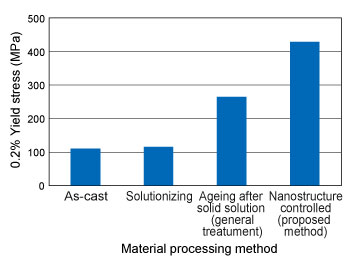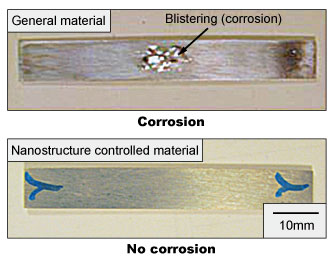3. Method for improving aluminium alloy properties through nanostructure control
- A thermomechanical processing method was proposed to produce a higher performing aluminium alloy for use on Shinkansen train car bodies with nanostructure control of its metallic microstructure
- Verification was made of improved strength and resistance to corrosion.
In order to further lighten the structure of high speed vehicles, research has been carried out to improve the properties of thermomomechanically processed aluminium alloy. Aluminium alloy properties depend essentially on size of its crystal grain and precipitate size.
Research so far has managed to reduce the crystal grain size down to the order of a micron in diameter (10-6m), which increases strength but weakens other properties such as resistance to corrosion. Subsequent work therefore sought to develop a material processing method which not only improved strength but also other properties such as resistance to corrosion and workability. Following this, the precipitates in the aluminium alloy currently used on car body shells were analyzed and a method for bringing precipitate grain diameter to nano scale (10-9m) was proposed based on a thermomechanical process comprising a combination of rolling and thermal processing. One of the key properties sought for the Al-Mg-Si alloy 6N01 is high strength against buckling. By adapting the proposed method confirmation was obtained that the plastic deformation limit (0.2% yield strength) was higher by a factor of 1.5 than ordinary materials produced by solution and ageing treatment (Fig.1) .
The objective with 7000 series aluminium alloys was to improve strength and resistance to corrosion. Confirmation was obtained that Al-Zn-Mg 7075 was not only strengthened but also had improved resistance to corrosion (Fig.2). By employing the proposed nanostructure control method which increases material strength, it should be possible to reduce material thickness while maintaining resistance to corrosion and reduce the weight of coating, and ultimately lighten the car body structure.

Fig.1 Resulting increase of yield resistance to 0.2% after applying the nanocontrol method (Al-Mg-Si: AA 6N01)
Fig.2 Stress corrosion cracking resistance tests showing comparative resistance to corrosion (Al-Zn-Mg: AA 7075)